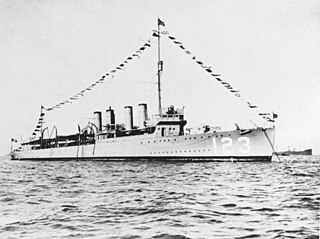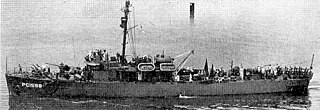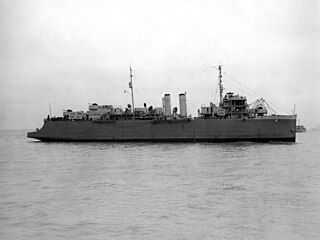
USS Gamble (DD–123/DM-15) was a Wickes-class destroyer in the United States Navy during World War I, later converted to a minelayer in World War II.

USS Ramsay (DD-124) was a Wickes-class destroyer in the United States Navy during World War I, reclassified as DM-16 during World War II and again reclassified as AG-98. She was the first ship named for Rear Admiral Francis Ramsay.

USS Tracy (DD-214/DM-19) was a Clemson-class destroyer in the United States Navy during World War II. She was the only ship named for Secretary of the Navy Benjamin Franklin Tracy.

USS Indus (AKN-1) was the lead ship of the Indus-class of converted Liberty ship net cargo ships in the service of the United States Navy in World War II. Named after the constellation Indus, it was the only ship of the Navy to bear this name.
USS Sagittarius (AKN-2) was an S-class Indus net cargo ship in the service of the United States Navy in World War II. Named after the constellation Sagittarius, it was the only ship of the Navy to bear this name.
USS Tuscana (AKN-3) was an Indus-class net cargo ship in the service of the United States Navy in World War II. Probably named after a variant spelling of the constellation Tucana, it was the only ship of the Navy to bear this name.

USS Zebra (AKN-5) was an Indus-class net cargo ship in the service of the United States Navy in World War II. The ship was originally the Matthew Lyon, an EC2-S-C1 Liberty ship, operated for the War Shipping Administration (WSA) as a cargo vessel by an agent until severely damaged by torpedo in August 1943. While at Espiritu Santo in the New Hebrides awaiting likely scrapping the Navy acquired the vessel under bareboat charter to be used as a net cargo ship transporting reclaimed anti-submarine netting.

USS Terror (CM-5) was a fleet minelayer of the United States Navy, the only minelayer of the fleet built specifically for and retained for minelaying during World War II.

USS Sheldrake (AM-62/AGS-19) was an Auk-class minesweeper built for the United States Navy during World War II. The ship was named after the sheldrake duck. The ship earned four battle stars during World War II. She was converted to a survey ship and re-designated AGS-19 in 1952 and remained in commission until 1968. She was sold for scrap in 1971.
USS Motive (AM-102) was an Auk-class minesweeper built for the United States Navy during World War II. She earned three battle stars for World War II service. She was decommissioned in 1946 and placed in reserve where she remained until struck from the Naval Vessel Register in December 1966. She was sunk as a target in April 1968.

USS Chief (AM-315) was an Auk-class minesweeper acquired by the United States Navy for the dangerous task of removing mines from minefields laid in the water to prevent ships from passing, and named after the word "chief," the head or leader of a group.
The second USS Chimo (ACM-1) was the lead ship of her class of minelayers in the United States Navy during World War II.

USS Monadnock (ACM-10) was a coastal minelayer in the U.S. Navy, the third vessel named after Mount Monadnock, a solitary mountain (monadnock) of more than 3,100 feet in southern New Hampshire close to the border of Massachusetts. The ship was built as the cargo vessel Cavalier for the Philadelphia and Norfolk Steamship Company by Pusey and Jones Corporation, Wilmington, Delaware in 1938. The Navy purchased the ship 9 June 1941 for wartime use. After decommissioning the ship was sold in June 1947 for commercial use then sold to a Panamanian company in 1949 to be renamed Karukara. In 1952 the ship became Monte de la Esperanza for a company in Bilbao, Spain transporting bananas to the United Kingdom from the Canary Islands for more than 20 years. She was later sold to the Marine Institute of Spain for operation as a hospital ship for more than 10 years serving the fishing fleet of the Canary Islands as Esperanza del Mar until becoming an artificial reef off Spain in 2000.

USS Miantonomah (CM-10/CMc-5) was built as SS Quaker by Pusey & Jones Corporation, Wilmington, Delaware in 1938 as a commercial coastwise ship operating as a fast inland water passenger and freight carrier. Quaker was acquired by the Navy in May 1941 for conversion to a coastal minelayer. Miantonomah operated off the east coast of the United States, Africa and the Mediterranean and took part in the invasion of Europe in 1944. The ship was sunk by a mine 25 September 1944.

USS Excel (AM-94) was an Adroit-class minesweeper of the United States Navy. Laid down on 19 December 1941 by the Jakobson Shipyard, Inc., Oyster Bay, Long Island, New York, launched on 10 May 1942, and commissioned on 11 December 1942. The ship was reclassified as a submarine chaser, PC-1598 on 1 June 1944.

USS Salem (CM-11) was a commercial cargo ship, that served as a minelayer and then net laying ship of the United States Navy during World War II.

USS Weehawken (CM-12) was originally SS Estrada Palma – a car ferry built in 1920 by William Cramp & Sons of Philadelphia. It was acquired by the United States Navy on 15 June 1942; renamed Weehawken on 18 July 1942; converted to a minelayer by the Bethlehem Steel Co. at Hoboken, New Jersey; designated CM-12; and commissioned on 30 September 1942.

USS Dionne (DE-261) was an Evarts-class destroyer escort of the United States Navy during World War II. She was sent off into the Pacific Ocean to protect convoys and other ships from Japanese submarines and fighter aircraft. She performed escort and antisubmarine operations in dangerous battle areas and returned home with six battle stars, a high number for a ship of her type.
USS Pavo (AK-139) was a Crater-class cargo ship commissioned by the U.S. Navy for service in World War II, named after the constellation Pavo. She was responsible for delivering troops, goods and equipment to locations in the war zone.

USS James M. Gilliss (AMCU-13/YMS-262) was a YMS-1-class minesweeper of the YMS-135 subclass named after James Melville Gilliss, a US naval officer credited with establishing the US Naval Observatory.















